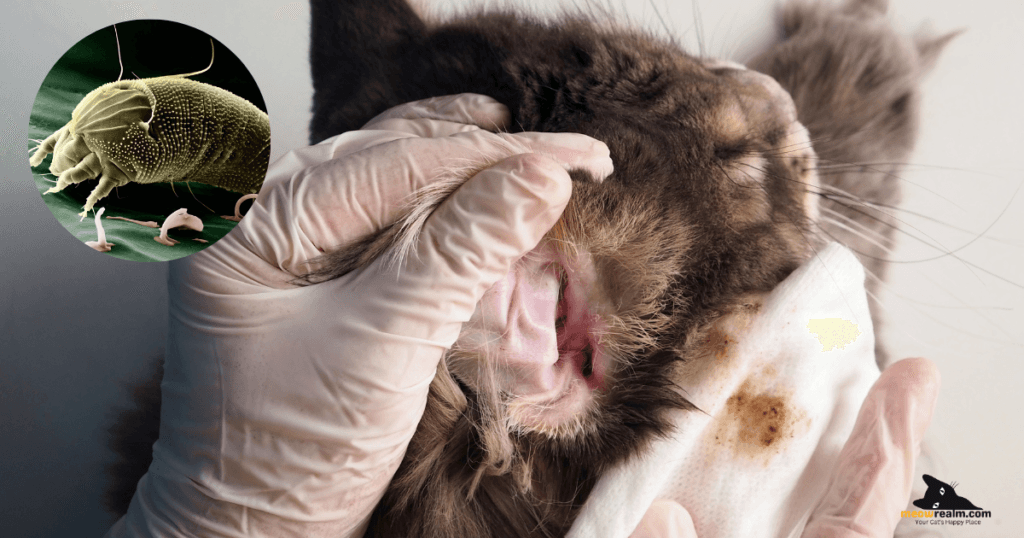How to get rid of ear mites in cats – Have you noticed your cat scratching its ears or shaking its head more than usual? If so, ear mites might be the cause. These tiny parasites can create a lot of discomfort, leading to itching, redness, and even infections if not promptly treated. Ear mites are surprisingly common, but with a little guidance, you can handle them effectively and keep your furry friend healthy and comfortable. In this guide, we’ll cover everything you need to know about ear mites, from identifying symptoms to applying safe treatments at home. Let’s get started on the path to helping your cat feel better!
Table of Contents
What Are Ear Mites? how to get rid of ear mites in cats.

Ear mites, scientifically known as Otodectes cynotis, are microscopic parasites that live in the ear canals of cats. They thrive in warm, dark environments and feed on skin oils and earwax. Ear mites are highly contagious among animals, especially in households with multiple pets or outdoor cats.
If left untreated, ear mites can lead to severe itching, inflammation, and secondary infections. Identifying and addressing them quickly is essential to avoid discomfort for your cat and potential health issues.
Symptoms of Ear Mites in Cats : how to get rid of ear mites in cats.
Knowing what to look for can help you catch an ear mite infestation early. Here are some of the most common signs that your cat might be dealing with these pesky parasites:
- Frequent Ear Scratching: If your cat seems to scratch its ears excessively, it could be a sign of irritation caused by ear mites.
- Head Shaking: Shaking the head is another way cats try to relieve the discomfort caused by mites.
- Dark, Coffee-Ground-Like Discharge: Look for a dark, crumbly discharge in your cat’s ears, often described as resembling coffee grounds.
- Redness and Inflammation: Mites can cause irritation and redness in and around the ear canal, which may lead to further infection if untreated.
If you spot these symptoms, it’s a good idea to take a closer look and consider seeking a veterinarian’s confirmation.
How to Get Rid of Ear Mites in Cats at Home – how to get rid of ear mites in cats
Safe and Effective Home Remedies
- Cleaning the Ears
Regular cleaning can help remove debris and reduce irritation. Here’s how to clean your cat’s ears safely:- Use a cotton ball and a gentle ear-cleaning solution (avoid cotton swabs).
- Gently lift your cat’s ear and wipe away any visible dirt or discharge.
- Avoid pushing anything deep into the ear canal, as this can cause damage.
- Using Natural Remedies
Natural oils can be effective at smothering mites, reducing their numbers and easing irritation. Here’s a simple recipe for a home remedy:Ear Cleaning Solution Recipe:IngredientQuantityPurposeMineral Oil1 tspSoothes skin and helps remove waxOlive Oil1 tspSmothers mites, reducing discomfortInstructions:- Mix the oils together.
- Apply a few drops to the outer part of the ear (not deep into the canal) and gently massage the base of the ear.
- Wipe away excess oil with a soft cloth.
While these treatments can help reduce the mites, a vet’s intervention may still be necessary to ensure the mites are entirely eradicated.
Veterinary Treatments for Ear Mites – how to get rid of ear mites in cats

If home treatments don’t resolve the issue, prescription treatments from your vet are effective and fast-acting.
- Prescription Treatments
Vets often prescribe medications like Revolution or Advantage Multi, which kill mites effectively. These treatments are safe and usually require only a single application. Follow your vet’s instructions carefully for the best results. - Over-the-Counter Options
Some over-the-counter ear mite treatments can be effective as well. Look for ear drops or sprays specifically designed for cats. These are often available at pet stores or online. Remember to read the labels and consult with your vet if you’re unsure about using a particular product.
Preventing Ear Mite Infestations in Cats – how to get rid of ear mites in cats
Preventing ear mites can save your cat a lot of discomfort and reduce the risk of recurrence. Here are some practical steps you can take to keep mites at bay:
- Routine Ear Cleaning
Cleaning your cat’s ears regularly can prevent wax buildup, which can attract mites. Aim for once every few weeks, but always use cat-safe products and avoid going too deep into the ear canal. - Avoiding Contact with Infected Animals
If you have multiple pets, keep an eye on them and avoid letting them interact with other animals showing signs of ear mites. Mites spread easily, especially in households with more than one pet. - Regular Vet Check-ups
Routine vet visits are an excellent way to catch infections early. A quick check of the ears during a regular appointment can reveal issues before they worsen.
By following these preventative steps, you can help keep your cat’s ears mite-free.
Frequently Asked Questions
Here are some common questions and answers to clear up any lingering doubts:
| FAQ | Answer |
|---|---|
| Can humans get ear mites from cats? | It’s rare, but humans are unlikely to contract ear mites from cats. Washing your hands after handling pets can help prevent cross-contamination. |
| How long does it take to get rid of ear mites in cats? | With treatment, symptoms should improve within a week, but full elimination may take up to 3 weeks. |
| What should I do if my cat’s ear mites come back? | If symptoms return, a vet visit is essential to explore additional treatment options. |
| Are ear mites contagious between pets? | Yes, ear mites spread quickly between animals in close contact, like cats and dogs in the same home. |
Ear mites are a common issue, but with prompt and effective treatment, you can help your cat feel relief and avoid future discomfort. Whether you choose a home remedy or opt for a veterinary prescription, addressing the problem early is key to keeping your pet healthy. Don’t forget that preventive measures, like regular ear cleaning and avoiding contact with infected animals, can go a long way in preventing recurrence

